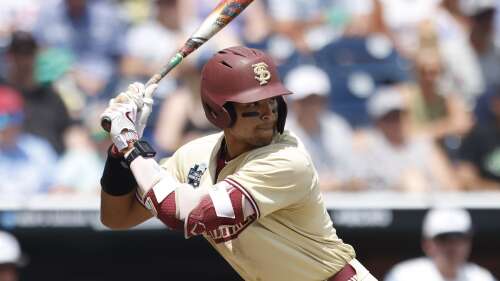Florida State infielder Cam Smith (24) in action during an NCAA College World Series baseball game against North Carolina on Tuesday, June 18, 2024, in Omaha, Neb. Florida State won 9-5. (AP Photo/Mike Buscher)
AP
The major-league schedule resumes Friday, so let’s try to recap some local highlights from the MLB draft, which ran from Sunday to Tuesday.
This draft was billed as a good year for college bats and the Cubs based their draft strategy on that assessment, focusing on hitters in the early rounds, then pitching on Day 3.
Besides first-round pick Cam Smith, a third baseman from Florida State, the Cubs picks that stand out are two high school players.
They took Miami shortstop Ronny Cruz in the third round. He was born in the Dominican Republic, moved to Florida for high school and is just 17. He missed some of his senior season with a knee injury, so the Cubs felt like they might have gotten the jump on an under-the-radar prospect.
A photo of Cam Smith is displayed on the video board after Smith was selected 14th overall by the Chicago Cubs in the first round of the MLB baseball draft in Fort Worth, Texas, Sunday, July 14, 2024. (AP Photo/LM Otero)
AP
“He’s young, he’s got a dynamic skill set at a premium position,” Cubs scouting director Dan Kantrovitz said. “The ball’s coming off his bat as hard as anybody at the combine.”
The Cubs have a large bonus offer prepared for 6-foot-4 left-handed hitting outfielder Eli Lovich, an Arkansas commit and Kansas City-area native. The 11th-round pick attended one of the team’s prospect camps in Mesa, Arizona.
“Ty Nichols, our area scout, first saw him play and said, ‘This is one of the better bats I’ve seen all spring,’” Kantrovitz said “Not just in a high school projection demographic, but in general. He rose the flag early on and got lot of our guys in there to see him.”
Another player worth noting is fifth-round catcher Ariel Armas from University of San Diego. Kantrovitz called him one of the best defensive backstops in college baseball this spring.
Sox pull off power plan:
A photo of Hagen Smith is shown on the video board after Smith was selected fifth by the Chicago White Sox in the first round of the MLB baseball draft in Fort Worth, Texas, Sunday, July 14, 2024. (AP Photo/LM Otero)
AP
The White Sox focused on trendy tools in the draft, landing some power pitchers, left-handed throwers, power bats and speed. At the top the Sox took two left-handed pitchers, Hagen Smith from Arkansas and Blake Larson of IMG Academy.
Second-round pick Caleb Bonemer, a shortstop from Okemos (Michigan) High School, performed well against some high-level competition. Scouting director Mike Shirley raved about being able to land outfielders from major college programs, like Virginia’s Casey Saucke (fourth round) and Arizona State’s Nick McLain (third round), brother of Reds shortstop Matt. Fifth-rounder Sam Antonacci from Coastal Carolina is a Springfield native.
“We attacked some power arms.” Shirley said. “Blake Sherpardson (from University of San Francisco) in 11th round, up to 101-102 mph. Pierce George from Alabama, I think someone had him at 103 on his gun this year.”
Bowling Green outfielder Nathan Archer (12th round) was MAC player of the year and is said to have blazing speed. Shirley claimed Pitt right-hander Phil Fox (seventh round) has “the flattest fastball in the draft.” The Sox plan to turn Alabama outfielder T.J. McCants (16th round) into a utility player.
One White Sox draft pick who has already gotten some attention is 17th-rounder Lyle Miller-Green, a DH and right-handed pitcher from Austin Peay. He was born in Siberia, adopted by an American couple at nine months, and grew up in Northern Virginia. He’s likely a hitter first, posting a .354 average with 16 home runs this spring.
“The power’s as good as anybody in the draft,” Shirley said. “He’s done nothing but answer the bell on challenges in his life.”
The Sox took Florida State commit Myles Bailey in the 20th round. He seems like a long shot to sign, but that may depend on bonus money needed to sign other picks.
NIL interference
Both Mike Shirley and Dan Kantrovitz made comments about how expensive it’s getting to sign high school players. The Cubs and Sox each drafted just three high school players out of 20 rounds.
Shirley was pretty direct in his complaints about how college NIL is affecting the MLB draft.
“Sometimes I get frustrated because I feel like college baseball is setting the marketplace more so than Major League Baseball is setting the marketplace,” Shirley said. “I’m always shocked by the dollar figures that are being shared into that world. I think it’s something we have to pay attention to.”
One of Shirley’s points is the most talented players should be preparing themselves to reach the major leagues. They might be better off playing in the minors, where the focus is on player development, rather than a college team where the primary goal is to win games.
“We need college baseball, it’s a great product they have going right now,” Shirley said. “But we have to be careful they’re not getting in the way of a Major League Baseball draft and us acquiring the players.”
